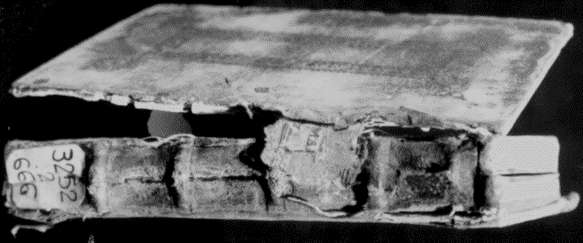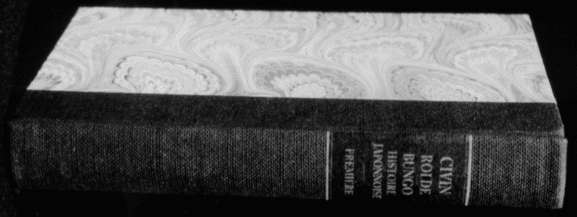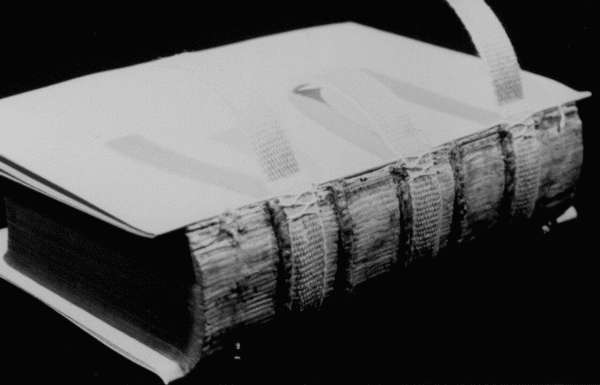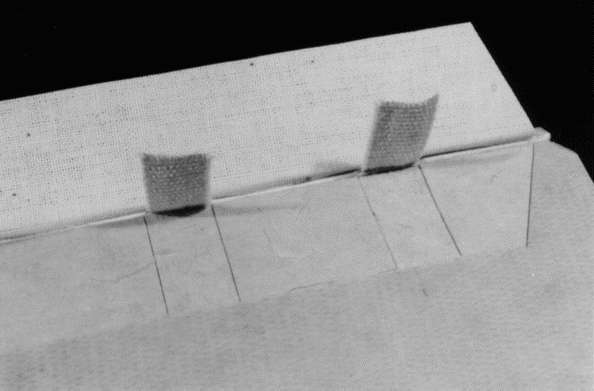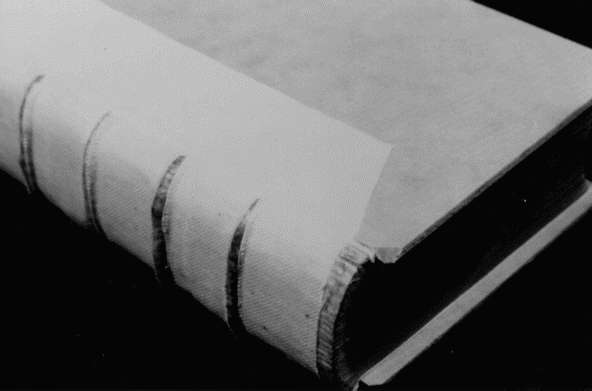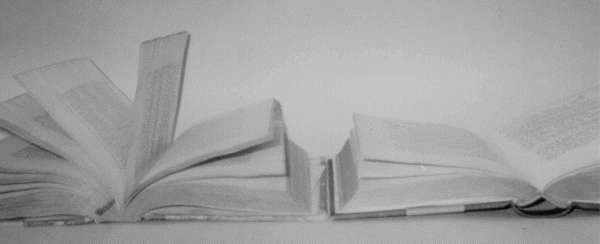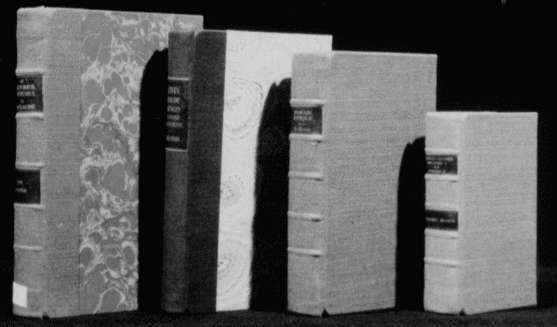Treatment 305: A Collections Conservation Approach to Rebinding
by Brian J. Baird and Mick LetourneauxMany older research libraries, have thousands of books from the eighteenth and early nineteen centuries in their open stacks--readily accessible to users. As a result, many of these older items circulate, get photocopied, and receive damage. As more research libraries retrospectively convert their card catalogs into machine readable formats, and as this information is distributed nationally, access to older materials will increase, and use of this material will go up. Then current practices such as enclosures and leather consolidation will no longer be the most appropriate means of treatment. Conservators will be forced to consider new treatments that address both preservation and access issues.
Fig 1. Damaged book before treatment
Each year at Princeton we are faced with a substantial number of damaged items from the eighteenth and early nineteen centuries that require rebinding due to red-rotted and deteriorated leather, and failed binding structures. The number of damaged items needing to be rebound will increase as result of Princeton producing a computer version of their card catalog. To address the preservation and access needs of this material we developed Treatment 305--a tight joint binding structure that is sympathetic to bindings from the late eighteenth and early nineteenth centuries.1
Many of the book binding structures of the pre-case binding era are beautiful and well crafted. But due to the nature of the materials used in most of these bindings, conservators are faced with a large number of books that are printed on sound paper, but have weak, deteriorated bindings. Treatment 305 provides a conservationally sound, aesthetically pleasing, binding structure for pre-case binding era books that is congruous to the original binding structure of the book while addressing the collections conservation goals of increasing access to library materials, providing durable, protective binding structures, and treatment production.2
Fig 2. Book with a Treatment 305 binding
Qualities of Eighteenth and Early Nineteen Century Bindings
Eighteenth and early nineteenth century book bindings are generally characterized by their sound paper, supported sewing structures, laced-on-boards, tight joints, and leather bindings. These bindings, though often done in a high production setting, are generally well crafted, executed with precision, and aesthetically pleasing.
Books from the eighteen and early nineteenth centuries have many wonderful qualities, but they are not without their faults. Time and use have shown that the leather and laced-on sewing supports of these bindings break down along the outer hinge where all of the board action is focused at one point due to the tight joint. As a result of this inherent weakness conservators have developed a number of board reattachment techniques.3
Often, the spines on books from this era are too stiff due to over lining, and or being bound with tight backs. This stiffness often does not keep the book from laying open, but this is a function of the flexibility of the paper. However, the stiffness does cause cracks and breaks in the lining to occur where the spine is forced to flex. This makes cracked text blocks a common problem for books from this era.
We have observed that much of the thread and material used for the sewing supports in books from this era has become weak and brittle. This is usually a function of acids in the cords and threads themselves, but it is often compounded by the high acidity of the leather and animal glues on the spine. The detrimental effect of having leather directly on the spine of a book can be seen by comparing books that have had leather applied directly to the spine with those that have been lined first with a barrier of vellum or paper.
Treatment 305
Treatment 305 was developed by looking at the inherent strengths and weaknesses of eighteenth and early nineteenth century bindings just discussed. We also incorporated proven conservation techniques used in other binding styles where appropriate. The steps of how to perform this treatment will now be looked at along with a discussion of how and why various techniques were employed.
A book identified as a candidate for this treatment first has its cover removed, and its spine is cleaned. The text block is then evaluated to see if there are any breaks in the sewing and to determine the strength of the thread and sewing supports. After any necessary paper repair, and if the text block is sound, double folio end sheets are sewn onto tapes. The end sheets are anchored to the text block by sewing through the first and last three signatures of the text block.
If the text block does not have sound sewing the text is pulled, guarded, mended, and re-sewn. The sewing structure used in the re-sewing process is dependent upon the original binding style, the value of the book, and the type of covering material that will be used. Sewing onto cloth tapes is the usual method chosen because cloth tape has proven virtues of strength and flexibility when used as a sewing support.
Fig 3. Text block with end sheets sewn onto tapes
After the text block has the end sheets sewn on, it is placed in a job backer and the spine is given its shape. The desired shape is based on the original shape of the text block, and on the ideal shape needed for good book action.4
The rounded text block is then lined with a layer of Japanese paper and paste to form a reversible break away layer. When this barrier layer is dry another lining of tightly woven crash is applied to the spine with PVA. As a general rule no additional linings are added except occasionally when it is felt that the spine needs additional stiffness. Experience has shown that text blocks from this era tend to hold their shape and are fairly stiff by nature. It is, therefore, not desirable to add any more stiffness through spine linings than is absolutely necessary.
At this point false endbands are added when the original endbands are no longer in tact. These are made by wrapping cloth or paper around a piece of cord. The text block is then left in the job backer for about two hours to allow the adhesive time to dry.
Fig 4. Recessed Board
When the text block is removed from the job backer, the end papers are trimmed, and boards are cut and back cornered. The boards are attached to the text block by in-laying the crash and tapes into the outer surface of the board. When done properly the crash, tapes, and board should all be in the same plane.
Fig. 5. Crash and tapes in-laid into board
The board attachment is an important aspect of Treatment 305. This simple attachment solves many problems. First, it is an easy, quick method of providing a laced-on type of board attachment. Secondly, the crash provides a tightly woven cloth hinge that runs most of the length of the board. The crash and cloth tapes help strengthen this inherent weak spot in tight joint bindings by providing further strong, flexible material in addition to the covering material on which the board can hinge.
The covering material chosen is based on the individual book. Efforts are made to chose a covering material that will be most sympathetic to the original binding material and style, but also address collections conservation issues of permanence, durability, and production. The most common method of covering employs the use of a cotton-linen blend material.5 This material is very strong and readily accepts dyes.6
Before dying, the cloth is lined with Japanese mulberry paper using wheat paste-PVA mixture. The cloth is then sized with the same mixture and dried under pressure between spun polyester and blotter. When the cloth is just damp enough to be cool to the touch it is calendered between mylar and board in a standing press. The calendering process gives the cloth a finished look and feel. When the adhesive is dry, the cloth is dyed using alcohol based dyes. Alcohol based dyes are chosen because of their ease of use, even distribution, and quick drying time.
There are some important aspects about the cloth that should be mentioned. First, the cotton-linen blend was chosen for its strength and fold endurance. The covering material must be able to withstand heavy use. The cloth must also be strong enough to stand up to flexing through the joint areas.
Second, the cloth is lined with Japanese mulberry paper to add strength, but to also add stiffness in the spine area. This treatment is not a tight back binding. There is also no paper spine inlay or hollow tube employed in the binding. Paper spine inlays and hollow tubes create stress areas along their edges and act like knife edges which accelerate the breakdown of the spine of the cover. This stress, caused by flexing open the cover, is even more pronounced in a tight joint binding where all of the action is focused at one point rather than being distributed over a larger area as it is in other binding styles such a those employing a French joint.
When the cloth is prepared the book is covered by first adhering the cloth to one board. The cloth is then flexed around the spine and worked over the raised cords--if the book has them. The malleable Japanese paper and cotton-linen cloth works over raised cords well, and forms a headcap that maintains its shape. The second board is then glued out and the cloth is stretched tightly around the spine and onto the board. The turn-ins are made and the headcaps are formed. The paste downs are adhered to the board and the book is pressed over night.
The book is then labeled with a computer generated, laser printed label. When performed in batch mode this treatment takes an average of about three and a half hours to complete.
Fig. 6. A book given a Treatment 305 binding lays open flatter than a non-treated book
Uses of Treatment 305
Treatment 305 has many attributes that makes it a desirable and versatile binding style. Most important of these is that a book given this treatment opens well, lays flat, and withstands heavy use.
The binding is extremely sturdy. We bound a heavily used reference book with a Treatment 305 binding. After rebinding the book received daily use for over a year, but the binding shows no structural wear or fatigue. We chose to bind a large book that receives frequent use because we felt it would be a good test for this binding style. This book has the tell tale signs of heavy use--dinged boards, scuffs on the cover, and soiled pages and cover, but the structure has not been affected. The cover to text attachment is still strong and the cloth on the spine has maintained its shape and form despite not having a stiffener and there being false raised cords on the spine of the text block.
One year is not a long life for a binding, but this time is made more significant by the fact that this book was originally bound in a reinforced publishers binding that, despite being quite sturdy, had failed on this book within two months of it being placed on the shelf. From every indication, it seems that this book will be able to withstand heavy use for a very long time without any significant damage.
Another desirable attribute of this treatment is that the structure itself, while quick and easy to perform, is sympathetic to binding structures of the eighteenth and nineteenth centuries. To this basic structure can be added different types of covering materials and other variations that refine the binding and further help it match volume sets or specific period binding styles.
Conclusion
At Princeton University Libraries Treatment 305 serves a vital role by providing the Collections Conservation Unit a treatment for rebinding, when necessary, eighteenth and early nineteenth century material. This treatment provides a sturdy binding that will stand up to heavy use; a conservationally sound treatment that is reversible and non-damaging to the text block; and a high yield treatment that can be performed in a relatively short amount of time in batch mode. At Princeton, this treatment is used as the binding of choice for semi-rare materials in the general collections when rebinding is necessary.
This treatment bridges the gap between special collections book conservation, or single item treatment, and general collections conservation, or batch treatment, where most of the semi-rare material falls. In the past, much of this semi-rare material has been boxed in collections conservation projects, or ignored, never finding its way to the conservator's bench.
Fig. 7. Examples of Treatment 305 bindings
This treatment produces a durable, well functioning book that can withstand years of heavy use in an open stack research library. It also provides a binding that is sympathetic to the original binding structure of books from the eighteenth and early nineteenth centuries and is aesthetically pleasing.
In short, Treatment 305, with its variations, provides the conservator with an affirmative treatment for rebinding older, semi-rare material with sound paper, but with deteriorating bindings.
References
Baird, Brian J. "The Goals and Objectives of Collections Conservation," Restaurator 13 (1992): 149-161.
Cains, Anthony and Katherine Swift. Preserving our Printed Heritage: The Long Room Project at Trinity College Dublin. Dublin: Trinity College Dublin, 1988.
Conroy, Tom. "The Movement of the Book Spine," AIC Book and Paper Group Annual 6 (1987): 1-30.
Espinosa, Robert and Pamela Barrios. "Joint Tacketing: A Method for Board Reattachment," AIC Book and Paper Group Annual 10 (1991): 78-83
Minter, William. "The Use of Linen as a Book Covering Material," AIC Book and Paper Group Annual 4 (1985): 59-62.
Notes
1. This binding structure is called Treatment 305 at Princeton University Libraries' Collections Conservation Unit because a suitable name could not be found that readily describes it. In the Collections Conservation Unit, each treatment is given a three digit numeric code that is used internally to aid in recording treatment statistics. Because of the treatment cataloging sequence used in the unit, this new treatment was assigned the code 305. As there was no name for the treatment, the code was used to identify it and this name eventually stuck. The name Treatment 305 serves Princeton's internal purposes well, and we leave it to others to develop their own nomenclature.
2. Brian J. Baird, "The Goals and Objectives of Collections Conservation," Restaurator 13 (1992): 160.
3. Anthony Cains and Katherine Swift, Preserving our Printed Heritage: The Long Room Project at Trinity College Dublin (Dublin: Trinity College Dublin, 1988): 13, and Robert Espinosa and Pamela Barrios, "Joint Tacketing: A Method for Board Reattachment," AIC Book and Paper Group Annual 10 (1991): 78-83.
4. Tom Conroy, "The Movement of the Book Spine," AIC Book and Paper Group Annual 6 (1987): 8.
5. The material used is L-5040 55" Cotton/Linen-Natural cloth from Testfabrics, Inc. P.O. box 420 200 Blackford Ave., Middlesex, NJ 08846 (908) 469-6446. This cloth is chosen because it is free of dyes, resins, and sizing.
6. William Minter, "The Use of Linen as a Book Covering Material," AIC Book and Paper Group Annual 4 (1985): 59-62.
Brian J. BairdAssistant Preservation Librarian and General Collections Conservator
Princeton University Libraries
Mick LeTourneaux
Assistant General Collections Conservator
Princeton University Libraries
Publication History
Received: Fall 1994
Paper delivered at the Book and Paper specialty group session, AIC 22nd Annual Meeting, June 11, 1994, [PLACE].
Papers for the specialty group session are selected by committee, based on abstracts and there has been no further peer review. Papers are received by the compiler in the Fall following the meeting and the author is welcome to make revisions, minor or major.
